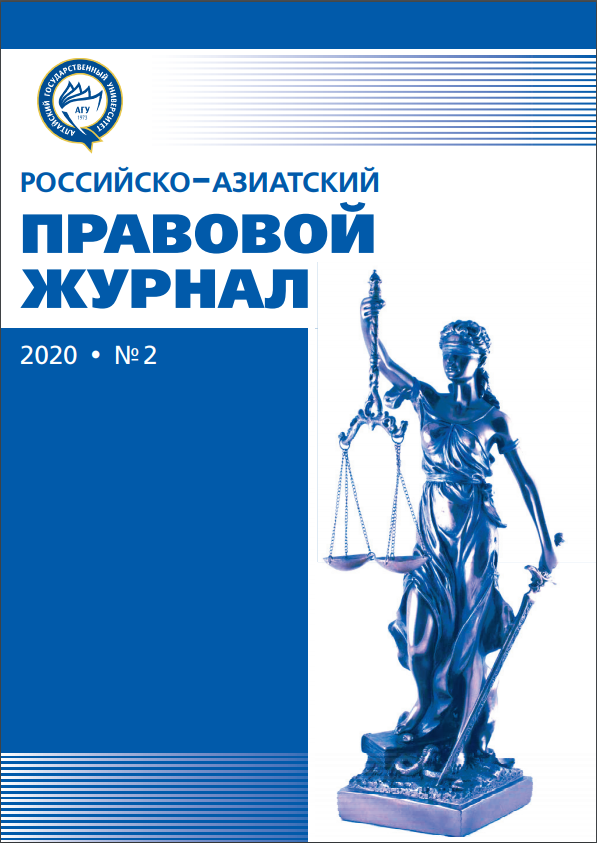THE NORMATIVE RESOLUTION OF THE SUPREME COURT OF THE REPUBLIC OF KAZAKHSTAN “ON THE PRACTICE OF THE COURTS APPLYING THE CRIMINAL LAW IN CASES OF CRIMES RELATED TO VIOLATION OF THE RULES OF THE ROAD AND THE OPERATION OF VEHICLES” DATED JUNE 29, 2011, AND THE CRIMINAL LAW
УДК 343:347.763 ББК 67.408
Abstract
The Concept of the legal policy of the Republic of Kazakhstan for the period from 2010 to 2020emphasizes that the criminal law must meet the requirements of legal accuracy and predictability ofconsequences, that is, its norms must be formulated with a sufficient degree of clarity and based on clearcriteria that exclude the possibility of arbitrary interpretation provisions of the law. Meanwhile, an analysisof the Criminal Code of the Republic of Kazakhstan shows that some articles on liability for road transportoffences are designed poorly. For example, Art. 346 of the Criminal Code of the Republic of Kazakhstan ischaracterized by a combination of formal and qualified corpus delicti, as well as two forms of guilt — intentand negligence; in Art. 351 of the Criminal Code of the Republic of Kazakhstan, the circle of subjects of thecriminal offence was significantly reduced due to the unjustified exclusion of drivers of non-mechanicalvehicles. As a result, the Supreme Court of the Republic of Kazakhstan in the regulatory decree «On thepractice of the courts applying the criminal law in cases of crimes related to violation of the rules of theroad and the operation of vehicles’ of June 29, 2011 made a number of errors and contradictions that led todifficulties in qualifying the criminal offence and the appointment criminal punishment. Taking into accountthe law-enforcement and legislative experience of Kazakhstan and other countries in the field of ensuringtraffic safety, the author proposes amendments and additions to the named regulatory decision of theSupreme Court of the Republic of Kazakhstan to improve its quality and improve law enforcement practice.
Downloads
References
2. О дорожно-транспортных происшествиях, повлекших гибель или ранение людей: статистический отчет Комитета по правовой статистике и специальным учетам при Генеральной прокуратуре Республики Казахстан. URL: http:// service.pravstat.kz/ portal/ page/portal/ POPageGroup/ Services/Pravstat (дата обращения: 12.01.20).
3. Национальный план мероприятий по реализации Десятилетия действий по обеспечению безопасности дорожного движения и предупреждения травматизма на 2011–2020 годы. URL: http://niito.kz/naczionalnyij-plan-po-realizaczii-meropriyatij-na-2011–2020-gg. (дата обращения: 12.01.20).
4. Сулейменова Г.Ж. Роль и значение нормативных постановлений Верховного суда РК // Судебная власть в Республике Казахстан: история и перспективы : сб. научных трудов. Караганда, 2003.
5. Юрченко Р.Н. О практике применения судами уголовного законодательства по делам о преступлениях, связанных с нарушением правил дорожного движения и эксплуатации транспортных средств. Комментарий к нормативному постановлению Верховного суда Республики Казахстан №3 от 29 июня 2011 года. URL: https://tengrinews.kz/zakon/verhovnyiy_sud_ respubliki_ kazahstan/ sudoppoizvodstvo/id-T1100000003/.
6. Бакишев К.А. О нормативном постановлении Верховного суда Республики Казахстан «О практике применения судами уголовного законодательства по делам о преступлениях, связанных с нарушением правил дорожного движения и эксплуатации транспортных средств» от 29 июня 2011 года // Российский судья. 2012. №9.
7. Бакишев К.А. Система Транспортных правонарушений в новом УК Республики Казахстан // Lex russica (Русский закон). 2015. Т. 101. №4.
8. О внесении изменений и дополнений в некоторые нормативные постановления Верховного суда Республики Казахстан по уголовному и уголовно-процессуальному законодательству. Нормативное постановление Верховного суда Республики Казахстан от 20 апреля 2018 года. URL: https:// sud.gov.kz/rus/ legislation/CAT01/ 79695/2018 (дата обращения: 14.01.20).
9. Рарог А.И. Квалификация преступлений по субъективным признакам. СПб., 2002.
10. Обобщение судебной практики рассмотрения уголовных дел о транспортных преступлениях, предусмотренных ст. 346 УК Республики Казахстан. URL: http: //office. sud.kz/ forumTaldau/forum.xhtml (дата обращения: 13.10.19).
11. Чучаев А.И., Пожарский А.Ю. Транспортные преступления: понятие, виды, характеристика. М., 2018.
12. Обобщение судебной практики рассмотрения уголовных дел о транспортных преступлениях, предусмотренных ст. 351 УК. URL: http://office.sud.kz/ forumTaldau/ forum. xhtml? content. (дата обращения: 15.10.19).
13. Коробеев А.И. Транспортные преступления. СПб., 2003.
14. Петров С.А. Уголовно-правовая характеристика участников движения при нарушении правил, обеспечивающих безопасную работу транспорта // Российский следователь. 2016. №7.
Russian-Asian Law Journal is a golden publisher, as we allow self-archiving, but most importantly we are fully transparent about your rights.
Authors may present and discuss their findings ahead of publication: at scientific conferences, on preprint servers, in public databases, and in blogs, wikis, tweets, and other informal communication channels.
Russian-Asian Law Journal allows authors to deposit manuscripts (currently under review or those for intended submission) in non-commercial, pre-print servers such as ArXiv.
Authors who publish with this journal agree to the following terms:
- Authors retain copyright and grant the journal right of first publication with the work simultaneously licensed under a Creative Commons Attribution License that allows others to share the work with an acknowledgement of the work's authorship and initial publication in this journal.
- Authors are able to enter into separate, additional contractual arrangements for the non-exclusive distribution of the journal's published version of the work (e.g., post it to an institutional repository or publish it in a book), with an acknowledgement of its initial publication in this journal.
- Authors are permitted and encouraged to post their work online (e.g., in institutional repositories or on their website) prior to and during the submission process, as it can lead to productive exchanges, as well as earlier and greater citation of published work (See The Effect of Open Access).








